The actions of ether, alcohol and alkane general anaesthetics on GABAA and glycine receptors and the effects of TM2 and TM3 mutations
- PMID: 10683198
- PMCID: PMC1571881
- DOI: 10.1038/sj.bjp.0703087
The actions of ether, alcohol and alkane general anaesthetics on GABAA and glycine receptors and the effects of TM2 and TM3 mutations
Abstract
The actions of 13 general anaesthetics (diethyl ether, enflurane, isoflurane, methoxyflurane, sevoflurane, chloral hydrate, trifluoroethanol, tribromoethanol, tert-butanol, chloretone, brometone, trichloroethylene, and alpha-chloralose) were studied on agonist-activated Cl(-) currents at human GABA(A) alpha(2)beta(1), glycine alpha(1), and GABA(C) rho(1) receptors expressed in human embryonic kidney 293 cells. All 13 anaesthetics enhanced responses to submaximal (EC(20)) concentrations of agonist at GABA(A) and glycine receptors, except alpha-chloralose, which did not enhance responses at the glycine alpha(1) receptor. None of the anaesthetics studied potentiated GABA responses at the GABA(C) rho(1) receptor. Potentiation of submaximal agonist currents by the anaesthetics was studied at GABA(A) and glycine receptors harbouring mutations in putative transmembrane domains 2 and 3 within GABA(A) alpha(2), beta(1), or glycine alpha(1) receptor subunits: GABA(A) alpha(2)(S270I)beta(1), alpha(2)(A291W)beta(1), alpha(2)beta(1)(S265I), and alpha(2)beta(1)(M286W); glycine alpha(1)(S267I) and alpha(1)(A288W). For all anaesthetics studied except alpha-chloralose, at least one of the mutations above abolished drug potentiation of agonist responses at GABA(A) and glycine receptors. alpha-Chloralose produced efficacious direct activation of the GABA(A) alpha(2)beta(1) receptor (a 'GABA-mimetic' effect). The other 12 anaesthetics produced minimal or no direct activation of GABA(A) and glycine receptors. A non-anaesthetic isomer of alpha-chloralose, beta-chloralose, was inactive at GABA(A) and glycine receptors and did not antagonize the actions of alpha-chloralose at GABA(A) receptors. The implications of these findings for the molecular mechanisms of action of general anaesthetics at GABA(A) and glycine receptors are discussed.
Figures
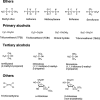
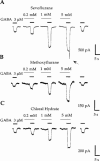
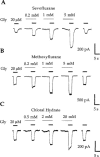
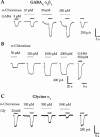

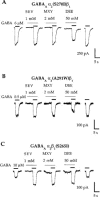
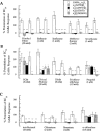
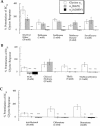
Similar articles
-
The interaction of general anaesthetics with recombinant GABAA and glycine receptors expressed in Xenopus laevis oocytes: a comparative study.Br J Pharmacol. 1997 Dec;122(8):1707-19. doi: 10.1038/sj.bjp.0701563. Br J Pharmacol. 1997. PMID: 9422818 Free PMC article.
-
Trichloroethanol modulation of recombinant GABAA, glycine and GABA rho 1 receptors.J Pharmacol Exp Ther. 1998 Mar;284(3):934-42. J Pharmacol Exp Ther. 1998. PMID: 9495852
-
The actions of sevoflurane and desflurane on the gamma-aminobutyric acid receptor type A: effects of TM2 mutations in the alpha and beta subunits.Anesthesiology. 2003 Sep;99(3):678-84. doi: 10.1097/00000542-200309000-00024. Anesthesiology. 2003. PMID: 12960553
-
Mechanism of action of general anaesthetics--new information from molecular pharmacology.Curr Opin Pharmacol. 2001 Feb;1(1):78-83. doi: 10.1016/s1471-4892(01)00013-3. Curr Opin Pharmacol. 2001. PMID: 11712540 Review.
-
General anaesthetics and their effects on GABA(A) receptor desensitization.Toxicol Lett. 1998 Nov 23;100-101:217-24. doi: 10.1016/s0378-4274(98)00188-x. Toxicol Lett. 1998. PMID: 10049145 Review.
Cited by
-
Dominant Alcohol-Protein Interaction via Hydration-Enabled Enthalpy-Driven Binding Mechanism.J Phys Chem B. 2015 Apr 30;119(17):5367-75. doi: 10.1021/acs.jpcb.5b00378. Epub 2015 Apr 17. J Phys Chem B. 2015. PMID: 25856773 Free PMC article.
-
Inhaled anesthetic responses of recombinant receptors and knockin mice harboring α2(S270H/L277A) GABA(A) receptor subunits that are resistant to isoflurane.J Pharmacol Exp Ther. 2011 Jan;336(1):134-44. doi: 10.1124/jpet.110.170431. Epub 2010 Aug 31. J Pharmacol Exp Ther. 2011. PMID: 20807777 Free PMC article.
-
A Comparison of Brain-State Dynamics across Common Anesthetic Agents in Male Sprague-Dawley Rats.Int J Mol Sci. 2022 Mar 25;23(7):3608. doi: 10.3390/ijms23073608. Int J Mol Sci. 2022. PMID: 35408973 Free PMC article.
-
Volatile Anesthetics Regulate Anti-Cancer Relevant Signaling.Front Oncol. 2021 Feb 26;11:610514. doi: 10.3389/fonc.2021.610514. eCollection 2021. Front Oncol. 2021. PMID: 33718164 Free PMC article. Review.
-
The alpha 1 and alpha 6 subunit subtypes of the mammalian GABA(A) receptor confer distinct channel gating kinetics.J Physiol. 2004 Dec 1;561(Pt 2):433-48. doi: 10.1113/jphysiol.2003.051839. Epub 2004 Oct 7. J Physiol. 2004. PMID: 15579538 Free PMC article.
References
-
- ALLOTT P.R., STEWARD A., FLOOK V., MAPLESON W.W. Variation with temperature of the solubilities of inhaled anaesthetics in water, oil and biological media. Br. J. Anaesth. 1973;45:294–300. - PubMed
-
- BANKS M.I., PEARCE R.A. Dual actions of volatile anesthetics on GABAA IPSCs: dissociation of blocking and prolonging effects. Anesthesiol. 1999;90:120–134. - PubMed
-
- BARNARD E.A., SKOLNICK P., OLSEN R.W., MOHLER H., SIEGHART W., BIGGIO G., BRAESTRUP C., BATESON A.N., LANGER S.Z. International union of pharmacology. XV. Subtypes of γ-aminobutyric acidA receptors: classification on the basis of subunit structure and receptor function. Pharmacol. Rev. 1998;50:291–313. - PubMed
Publication types
MeSH terms
Substances
Grants and funding
LinkOut - more resources
Full Text Sources
Other Literature Sources

